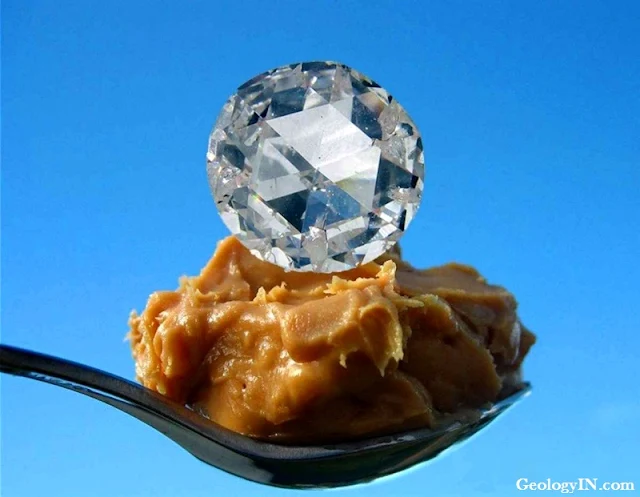Turn Peanut Butter to Diamonds? This Geologist Did It
 |
| In a lab, scientists have turned peanut butter into diamonds. Peanut butter, of course, is rich in carbon. |
A team of German scientists has made diamonds from scratch using none other than plain old peanut butter. The exercise might sound a little pointless, but it’s helping them understand exactly what the Earth is made of.
Scientists at the Bayerisches Geoinstitut in Germany are working on recreating the conditions of the Earth’s mantle - a thick, rocky layer that sits under the outer crust almost 3 kilometres below the surface. It’s a pretty important component for scientists to wrap their heads around, as it constitutes around 85 percent of the total mass and weight of our planet.
Led by geochemist Dan Frost, the team’s main job is to crush a bunch of rocks at the highest pressures possible to determine the exact composition of the biggest structural component of our planet. While it’s been assumed that the Earth’s mantle was made from materials that were flung about by the asteroid belt - the same materials that make up a meteorite - previous analyses have found that the mantle contains significantly less silicon than meteorite material. It’s Frost’s mission to figure out where all that silicon went.
“That recreates the conditions in the top layers of the lower mantle at around 800 or 90 km (500 to 562 miles) below the Earth’s surface, causing the atoms of the crystal to rearrange into denser structures.”
These minerals are then crushed even further under the pressure of an anvil made from two tiny diamonds. This allows the the team to recreate what a mineral would look like all the way down in the deepest parts of the lower mantle layer. The pressure exerted by the minuscule diamonds is about 1.3 million times that of Earth’s atmospheric pressure.
And here’s the genius part - Frost explains that while the minerals are still crushed inside the anvil, he takes measurements of how sound waves are travelling through them and compares this to how seismic waves travel through the layers of the Earth whenever there’s an earthquake or volcano eruption to figure out if their composition is the same.
According to Robinson, the results of Frost’s experiment have revealed that, as suspected, there isn’t enough silicon in the mantle materials to match meteorite material. It could be that it’s sunk right through the mantle, even as far down as the inner core, or maybe all the silicon went the other way and ended up in the very young Earth’s crust, only to be blasted free by impacting meteorites. That's what Frost and his team have to figure out next.
Another part of his research is to investigate how certain geological processes could have stripped carbon dioxide out of the Earth’s oceans and deposited it into its rocks, which were then pushed down into the mantle over billions of years and transformed into diamonds. But the problem with testing this theory is the sheer difficulty of creating a diamond from scratch in the lab.
"Frost is hardly likely to make a fortune from his harvest; the diamonds take an agonisingly long time to grow. ‘If we wanted a two-or-three-millimetre diamond, we would need to leave it for weeks,' he says.
That hasn’t stopped him experimenting with other sources for his diamond maker, however; at the behest of a German TV station, he attempted to create some diamonds from carbon-rich peanut butter. 'A lot of hydrogen was released that destroyed the experiment,' he says, 'but only after it had been converted to diamond.'
The above story is based on Materials provided by Bayerisches Geoinstitut.


%20(1).webp)





